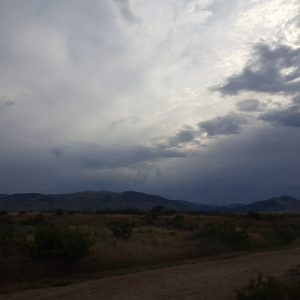The CLM internship is no cake walk. Our days are long, arduous, and exhilarating. Our mornings are early and turbo-charged. I don’t know how most people’s mornings go, but I need something quick, delicious, nutritious, and calorie-packed that I can eat with one hand as I swirl about packing all my other necessities for a 10-hour field day. I’m sure lots of people need a breakfast like this.
I give you: the quiche. Spend a couple hours on the weekend making one (or two), and you’ll have fantastic breakfast you can eat on auto-pilot all week. You can make several, cut them into servings, freeze them, and simply reheat in the morning – they’ll stay good frozen for about 2 weeks (if they last that long). And yes, you can make one. I promise.

9″ pie plate makes 6 servings, est. 400 calories each serving. This quiche has feta and cheddar cheeses, broccoli, spinach, and a little kale. Add or substitute suggested ingredients as you like!
Perfect Savory Pie Crust
Prep time: 15min
Wait time: 1 hour
- 1 1/4 cups all-purpose flour
- 1/4 tsp fine sea salt
- 10 Tbsp unsalted butter, chilled & cubed
- 2-4 Tbsp ice water, reserve in a wide-mouth dish
Quiche Filling
Prep time: 30-45min
Wait time: 1 hour
- 1 Tbsp butter or olive oil
- 1/2 cup of sliced shallots (sub: 1/4 cup diced onion or 3-4 Tbsp minced garlic)
- 10 oz (two big handfuls) fresh spinach and/or kale
- 1 1/2 cups broccoli, chopped
- Pinch or two each as you like of salt, cayenne, thyme, and oregano.
- 1 cup grated cheese. Consider cheddar, gruyere, feta, or Monterrey jack.
- 4 large eggs
- 1 1/4 cup heavy cream (sub: half & half thinned with water)
Directions
If you bought a pie crust (boo!!), preheat the oven to 325F and skip to step 8.
- Pulse the flour and salt together in a food processor. Add butter and pulse until the mixture looks like fluffy sand with pea-sized chunks of butter in it.
- If you don’t have a food processor, use a pastry cutter, a fork, or just crumble the butter and flour by hand.
- Add ice water, 1 tablespoon at a time, and pulse until the dough just comes together. It should stay in a ball if you press it in your hand, but not seem wet.
- On a clean counter, scatter a little flour. Turn out the dough onto the floured counter and gather it into a ball. Flatten the ball into a firm disk, wrap in a clean terry cloth towel or wax paper, and refrigerate for at least 1 hour or up to 2 days.
- When you’re ready to bake the quiche, remove the dough & let it warm on the counter for about 10 minutes. Lightly dust the counter and a rolling pin with flour. Roll out your dough to about 1/4″ thick. Start by gently rocking the rolling pin until the dough gives, then make longer strokes. Alternate rolling directions so you get a circle, not a weird oval.
- Preheat the oven to 400F.
- Gather the pie crust pancake by sliding your fingers under the dough, starting at the edges and working into the center until you can pick it up and transfer to a 9″ pie plate.
- Fold the overhanging edges inward into the pie plate, and pinch them so they look nice on the lip of the plate. Don’t worry if it doesn’t look like the store-bought crinkles, it’ll be good!
- Line your pie crust with some parchment paper, and pour in some dry beans to keep the crust weighted down. Or, use baking weights if you have them. Bake for 10-15min until just starting to brown, then remove from oven.
- Turn oven temperature down to 325F.
- Now you can either put the beans back in the jar, or throw them in the crock pot for a ready-made meal. Breakfast and lunch!!
- While the pie crust is baking, sauté the shallots (or onion or garlic) in butter. Add the broccoli and stir for about a minute, then add in the spinach until it is just wilted. Remove from heat.
- Whisk together the eggs and cream in a bowl, adding in your chosen seasonings & spices (salt, cayenne, oregano, thyme, etc.).
- Layer the green vegetables in your pie crust, and sprinkle cheese generously over the greens. Pour the egg mixture over the cheesy greens, and add more cheese on top. 🙂
- Bake your quiche at 325F for 50-55min. Top will be golden brown, a knife will come out clean but a little moist (not clumpy or runny). Remove quiche from oven and let stand 10min before serving. If making lots for later, let the quiche(s) cool completely and cover before refrigerating or freezing.
- Reheat quiche in a toaster oven for approx. 5min at 350F, or pop in microwave for 1 1/2 min on a medium-high setting.
Hope you enjoy!!
Stay fed out there, CLM Interns!














































